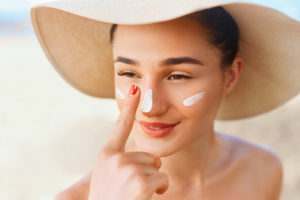
One of the best things you can do if you want to minimize skin aging is to protect your skin from the sun. That doesn’t mean you have to live like a vampire, limiting yourself to only venturing outside after sundown. What it does mean, though, is that you’ll want to do whatever you can to shield your skin during daylight hours.
Wearing wide-brimmed hats and long-sleeved shirts is one way to keep the sun off of your skin. Another way to protect yourself from sun damage is to slather on a good-quality sunscreen.
If you’ve visited the sunscreen aisle lately, you know that, like many other skincare products, you have a lot of choices when it comes to sun protection. With so many options available, how do you know which products to choose?
Here’s a quick guide to help you find the sunscreen that will work best for you.
Sun Protection Factor
One of the most important things to look for when choosing a sunscreen is the sun protection factor, aka “SPF.” SPF measures how long the sunscreen will protect you from the sun’s UV rays. In a perfect world, a sunscreen with an SPF of 30 would protect a person who would normally burn in 20 minutes for 10 hours.
One way to look at SPF is in terms of what percentage of the sun’s rays it blocks. A sunscreen with an SPF of 15 will block about 93% of the sun’s UV rays. Sunscreen with an SPF of 30 blocks about 97% of the sun’s UVB rays.
Although higher SPFs do provide more protection, they don’t scale up as much as you’d think. SPF 50 usually blocks about 98% of the sun’s burning UV rays while SPF 100 blocks about 99%. It’s usually recommended that you choose a sunscreen with an SPF of at least 30.
Other Things to Look Out for When Choosing Sunscreen
Two other things worth looking out for when choosing a sunscreen are the level of protection it offers and whether or not it is water-resistant. Ideally, you’ll choose a sunscreen that blocks both UVA (aging) and UVB (burning) rays.
Water-resistant sunscreen is also ideal, as it means that the sunscreen won’t rinse away the second you get a bit sweaty. It’s important to note that no sunscreens are “waterproof.” If you get wet, you’ll need to reapply.
Sunscreen Type
Another thing to think about when choosing a sunscreen is the way it blocks the sun’s harmful rays. Sunscreens come in two different types: physical and chemical.
A physical sunscreen physically blocks the sun, acting as a sort of shield on the surface of your skin. Physical sunscreens often contain active ingredients such as zinc or titanium oxide.
Chemical sunscreens protect your skin somewhat differently. Instead of blocking the sun’s rays, they absorb them, sort of like a sponge. Ingredients such as oxybenzone or avobenzone are usually a sign that a sunscreen is a chemical formula.
One advantage of chemical sunscreens is that they blend into the skin more easily than physical sunscreens. An advantage of physical sunscreens is that they are often gentle on sensitive skin and are generally better for the environment.
Sunscreen Format
Sunscreens come in a variety of formats, from lotions to sprays to solid sticks. Is one format better than the other?
Each format has its pros and cons. For example, lotions can be pretty easy to apply and can make it easy to see where you have already applied sunscreen. A drawback of sunscreen lotion is that it can sometimes be difficult to fully rub it into the skin and to eliminate any white residue.
Spray lotions can seem super easy to apply, but the potential risk of using them is that you don’t put on enough sunscreen or you miss spots because you aren’t able to see where you’ve already sprayed. To make sure you’re using enough spray sunscreen, apply it until your skin is shiny, then rub in.
The same is true of stick sunscreens. It can be easy to under-apply, leading to burns. One way to make sure that you’re using enough of a stick sunscreen is to make four back-and-forth passes in each area.
Applying and Reapplying Sunscreen
Whether you go with a lotion, stick, or spray, one thing is certain: You’ll need to reapply throughout the day to ensure that you’re adequately protected. It’s usually a good idea to reapply at least once every two hours. If you’re swimming or sweating, reapply more often, such as once every 70 to 80 minutes.
Want more advice and guidance on choosing the right sunscreen? The staff at Mirror Mirror Beauty Boutique in Houston, Texas is happy to help. We can work with you to help you put together a skincare routine that best meets your needs. To learn more, call 281-810-9083 to schedule an appointment today.